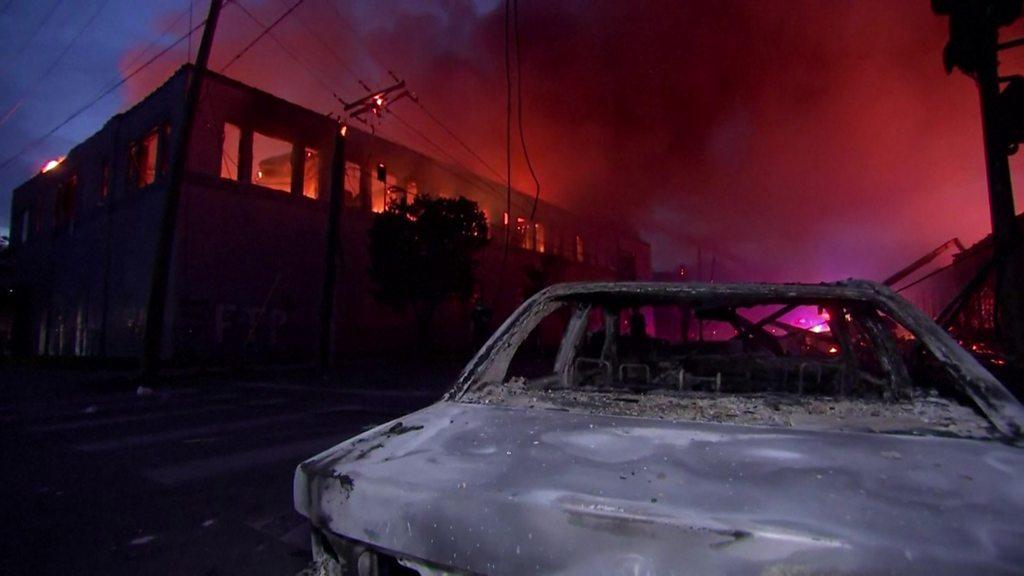George Floyd death: Clashes as protests spread across US
- Published
The mayor of Minneapolis said of the unrest: "This needs to stop"
Protesters have clashed with police in cities across the US over the killing of an unarmed African-American man at the hands of officers in Minneapolis.
Minnesota's governor said the tragedy of the death of George Floyd in police custody had morphed into "something much different - wanton destruction".
New York, Atlanta, Portland and other cities have seen violence, while the White House was briefly locked down.
An ex-Minneapolis policeman has been charged with murder over the death.
Derek Chauvin, who is white, was shown in footage kneeling on 46-year-old Mr Floyd's neck on Monday. He and three other officers have since been sacked.
Mr Chauvin, 44, is due to appear in court in Minneapolis for the first time on Monday.
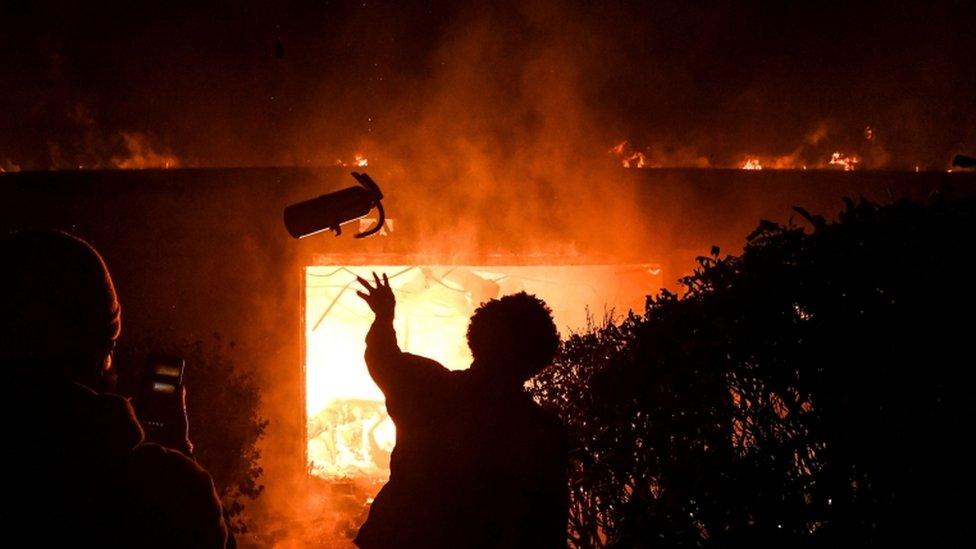
A protester throws a fire extinguisher into a burning building overnight in Minneapolis
President Donald Trump has described the incident as "a terrible, terrible thing" and said he had spoken with Mr Floyd's family, whom he described as "terrific people".
The Floyd case has reignited US anger over police killings of black Americans, and reopened deep wounds over racial inequality across the nation.
It follows the deaths of Michael Brown, Eric Garner and others, which have all occurred since the Black Lives Matter movement was sparked by the acquittal of neighbourhood watchman George Zimmerman in the shooting death of Trayvon Martin in 2012.
What's the latest on the protests?
Minnesota remains the most volatile region, with curfews ordered for the Twin Cities of Minneapolis-Saint Paul from 20:00 to 06:00 on Friday and Saturday evening.
Protesters defied the curfew on Friday. Fires, many from burning cars, were visible in a number of areas with fire officials unable to reach some sites.
Television pictures also showed looting in Minneapolis, with police officers thin on the ground.
US rapper Killer Mike: "It is your duty not to burn your own house down for anger with an enemy"
Only at about midnight (05:00 GMT) did police and National Guard troops move in in any numbers, the Star Tribune reports, external.
State Governor Tim Walz, in an early morning press briefing, described the situation as "chaotic, dangerous and unprecedented".
He said he took responsibility for "underestimating the wanton destruction and the sheer size of this crowd" when questioned about the lack of police on the streets.
He said the Guard deployment was the largest in state history but admitted "there's simply more of them than us". He said those on the streets "don't give one damn" about the stay-at-home order.
The Pentagon has put the military on alert for possible deployment in Minneapolis.
On Friday evening, crowds gathered near the White House in Washington waving photographs of Mr Floyd and chanting "I can't breathe" - invoking his last words and those of Eric Garner, a black man who died after being held in a police chokehold in New York in 2014.
The White House was then temporarily placed on lockdown, with the US Secret Service closing entrances and exits.
In Atlanta, a state of emergency was declared for some areas to protect people and property. Buildings were vandalised and a police vehicle was set alight as protesters gathered near the offices of news broadcaster CNN.
Mayor Keisha Lance Bottoms issued a passionate plea, saying: "This is not a protest. This is not in the spirit of Martin Luther King Jr. You are disgracing our city. You are disgracing the life of George Floyd."
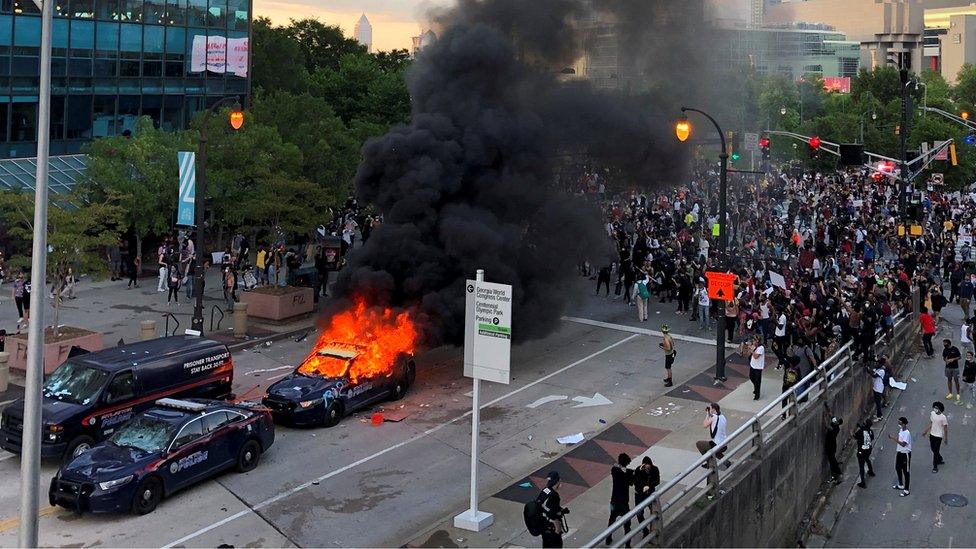
A police car burns as protesters gather near the CNN offices in Atlanta, Georgia
In New York's Brooklyn district, protesters clashed with police, throwing projectiles, starting fires and destroying police vehicles. A number of officers were injured and many arrests made.
Mayor Bill de Blasio tweeted: "We don't ever want to see another night like this."
The mayor of Portland, Oregon, has declared a state of emergency amid looting, fires and an attack on a police precinct. An immediate curfew until 06:00 local time (13:00 GMT) was imposed and it will restart at 20:00.
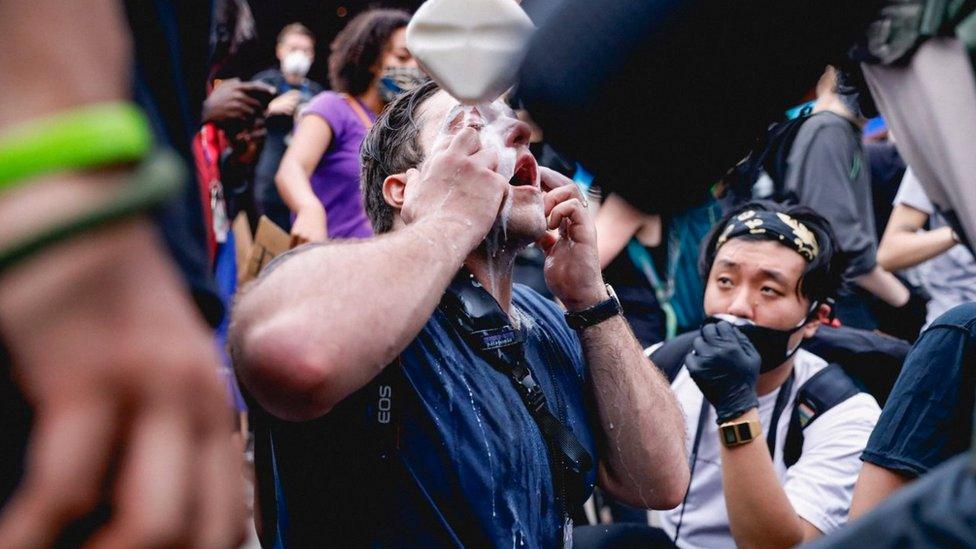
Protesters use milk to treat the sting of tear gas in New York City
In Detroit, police are investigating after a 19-year-old man was killed when a vehicle pulled up to protesters and shots were fired into the crowd.
In Dallas, officers launched tear gas canisters after they were pelted with stones, with tear gas also fired in Phoenix, Indianapolis and Denver.
Protesters blocked roads in Los Angeles and also in Oakland, where windows were smashed and "Kill Cops" graffiti sprayed.
What are the legal moves so far?
Mr Chauvin has been charged with third-degree murder and second-degree manslaughter over his role in Mr Floyd's death.
Mr Floyd's family and their lawyer, Benjamin Crump, said that this was "welcome but overdue".
The family said they wanted a more serious, first-degree murder charge as well as the arrest of the three other officers involved.
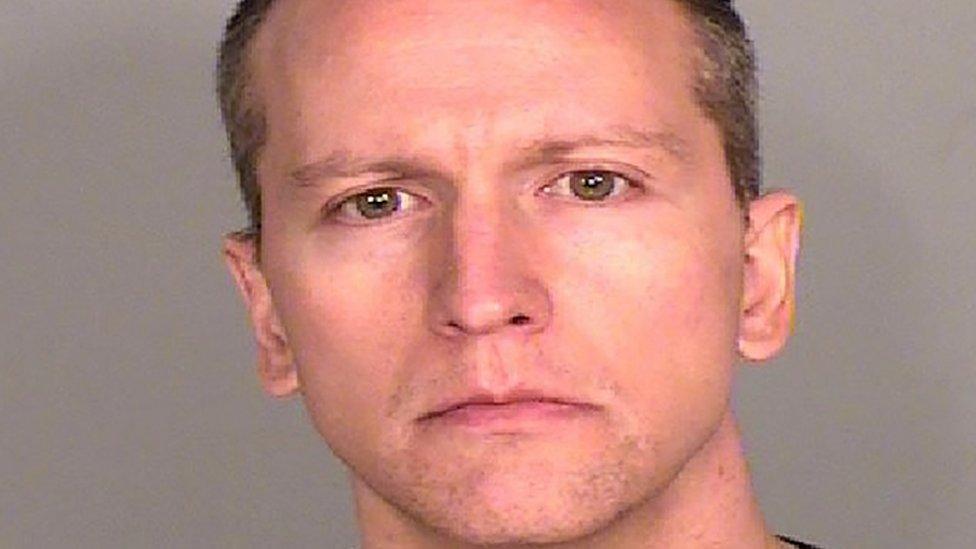
Derek Chauvin is due to appear in court in Minneapolis on Monday
Hennepin County Prosecutor Mike Freeman said he "anticipates charges" for the other officers but would not offer more details.
Mr Freeman said his office "charged this case as quickly as evidence has been presented to us".
"This is by far the fastest that we've ever charged a police officer," he noted.
According to the criminal complaint, Mr Chauvin acted with "a depraved mind, without regard for human life".
Meanwhile, Mr Chauvin's wife has filed for divorce, her lawyers say.
How did George Floyd die?
The full report by the county medical examiner has not been released, but the complaint states that the post-mortem examination did not find evidence of "traumatic asphyxia or strangulation".
The medical examiner noted Mr Floyd had underlying heart conditions and the combination of these, "potential intoxicants in his system" and being restrained by the officers "likely contributed to his death".
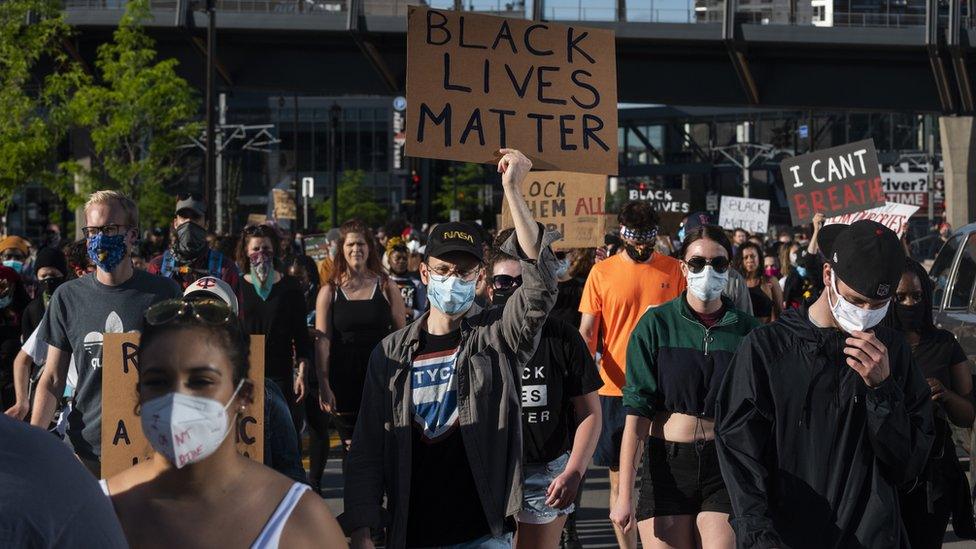
Demonstrations and protests have continued since Mr Floyd's death in police custody on Monday
The report says Mr Chauvin had his knee on Mr Floyd's neck for eight minutes and 46 seconds - almost three minutes of which was after Mr Floyd became non-responsive.
Nearly two minutes before he removed his knee the other officers checked Mr Floyd's right wrist for a pulse and were unable to find one. He was taken to the Hennepin County Medical Center in an ambulance and pronounced dead around an hour later.
The Minnesota police handbook states that officers trained on how to compress a detainee's neck without applying direct pressure to the airway can use a knee under its use-of-force policy. This is regarded as a non-deadly-force option.
What has the president said?
At the White House on Friday, Mr Trump said he had asked the justice department to expedite an investigation it announced on Friday into whether any civil rights laws were violated in Mr Floyd's death.
The president also said "looters should not be allowed to drown out the voices of so many peaceful protesters".
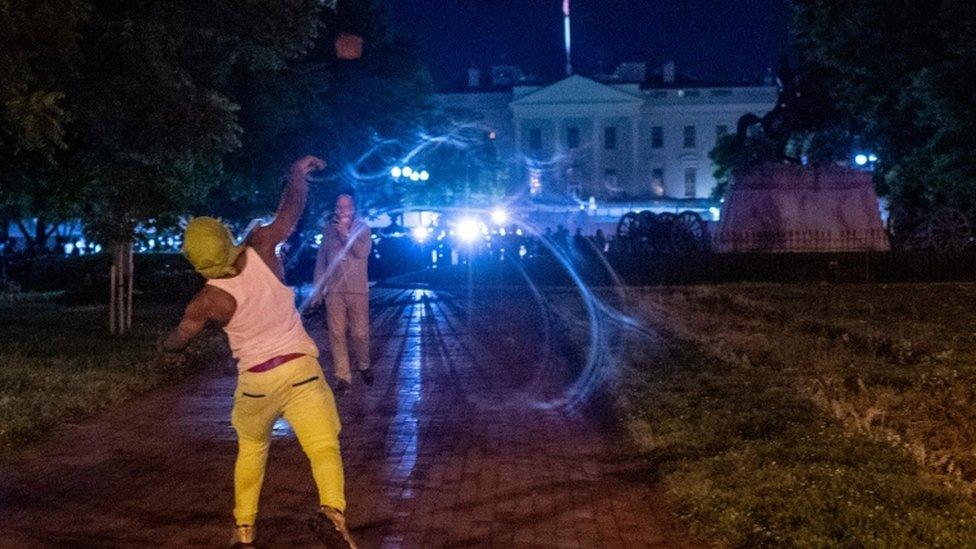
Protests continued outside the White House overnight
Earlier, he described the rioters as "thugs" who were dishonouring Mr Floyd's memory.
Social media network Twitter accused Mr Trump of glorifying violence in a post that said: "When the looting starts, the shooting starts."
What happened in the arrest?
Officers suspected Mr Floyd had used a counterfeit $20 note and were attempting to put him in a police vehicle when he dropped to the ground, telling them he was claustrophobic.
According to police, he physically resisted officers and was handcuffed.
Minnesota governor on George Floyd death: 'Thank God a young person had a camera to video it'
Video of the incident does not show how the confrontation started, but a white officer can be seen with his knee on Mr Floyd's neck, pinning him down.
Mr Floyd can be heard saying "please, I can't breathe" and "don't kill me".
A former local nightclub owner has said Mr Chauvin and Mr Floyd both worked as bouncers at her venue in south Minneapolis up until last year, though it is unclear if they knew one another.
- Published29 May 2020
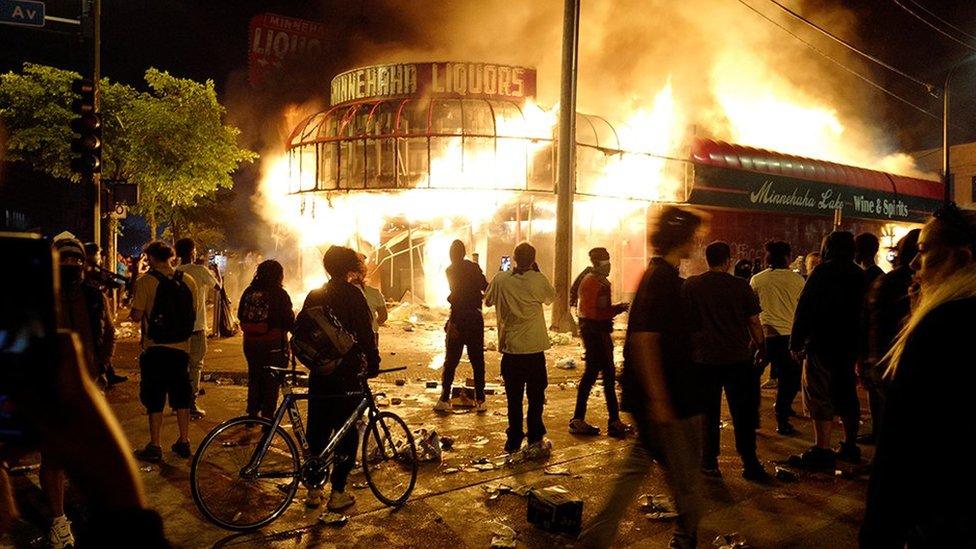
- Published29 May 2020
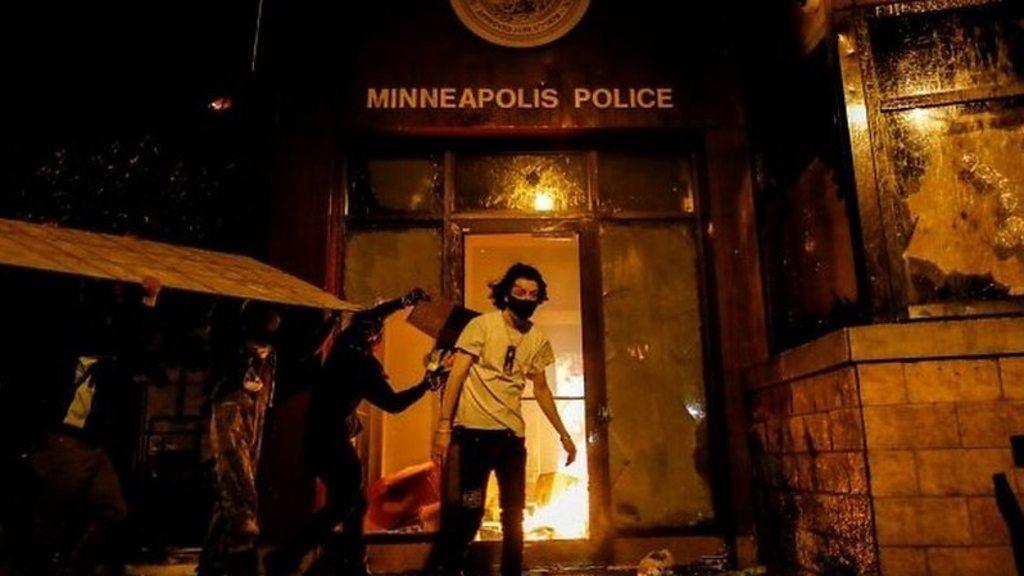
- Published29 May 2020
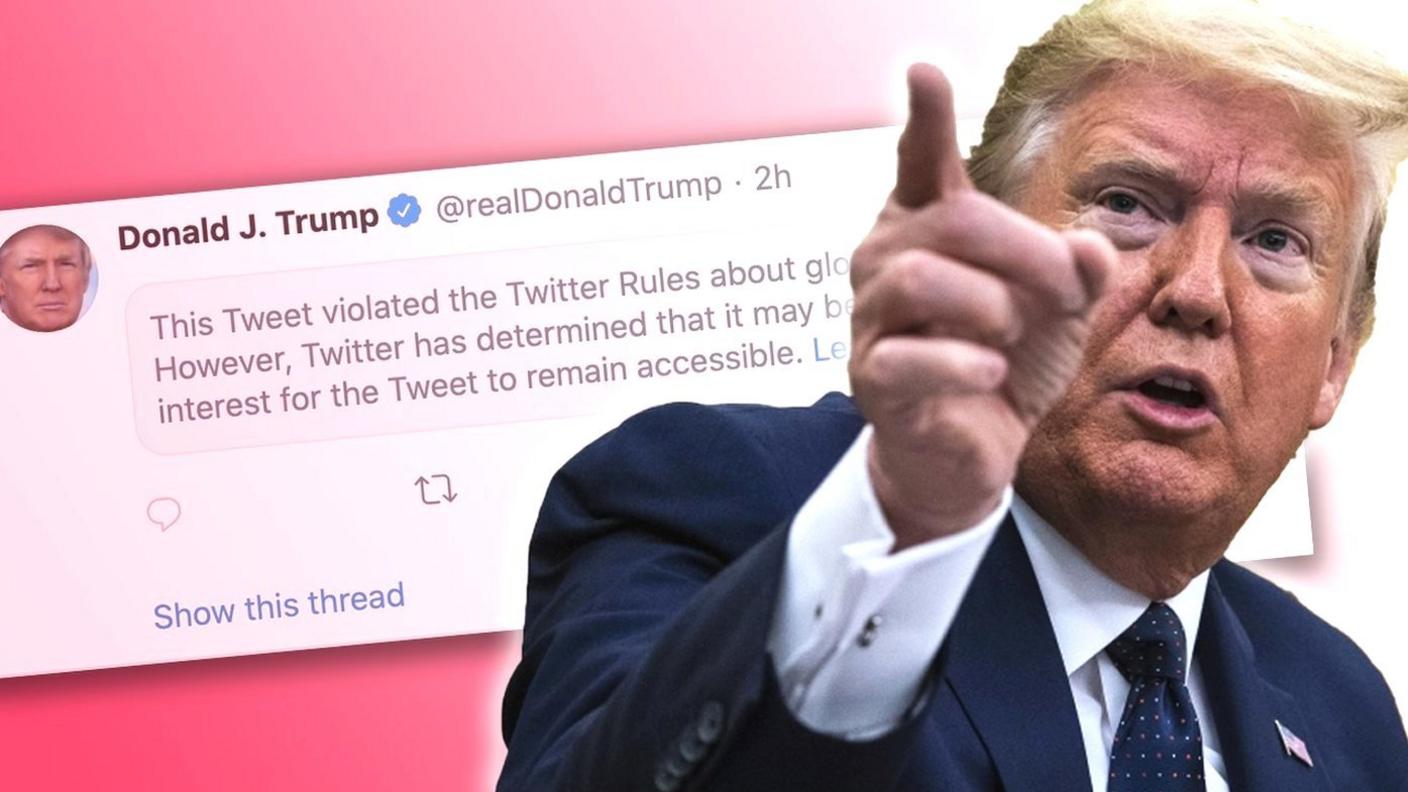
- Published28 May 2020
